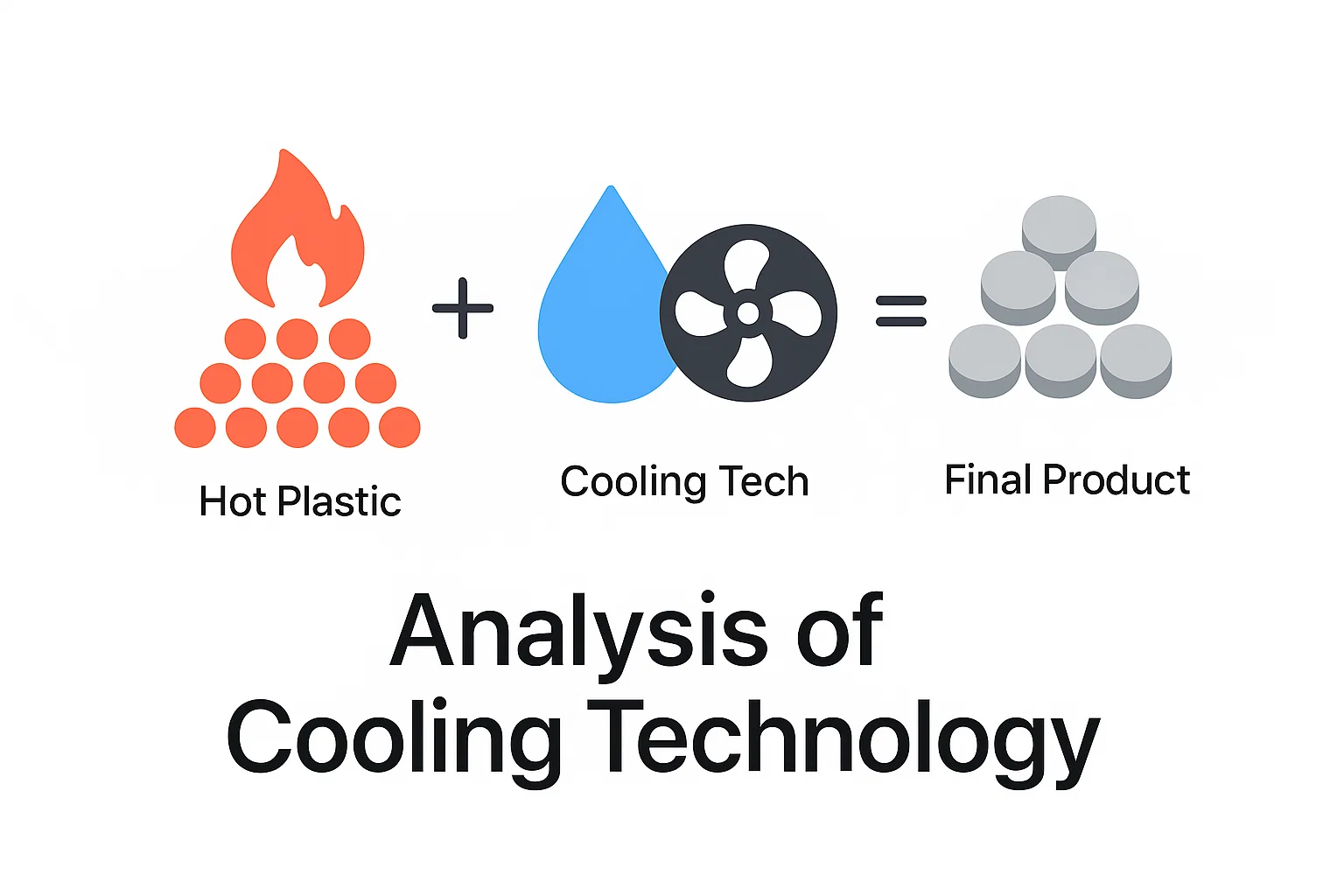[18] In de wereld van plastic recycling is de reis van afvalmateriaal naar hoogwaardige, herbruikbare korrels een bewijs van precisie-engineering. Hoewel de extruder en snijder van een [20] vaak de hoofdrol spelen, is het volgende koelproces minstens even cruciaal. Het is deze stilte, maar beslissende, fase die de uiteindelijke kwaliteit, consistentie en structuurintegriteit van de plastic korrels bepaalt. plastic pelletizing machine [21] Bij Rumtoo geloven we dat een geïnformeerde klant een geëmpowerde partner is. Het begrijpen van de nuances van koeltechnologie is essentieel voor het kiezen van het juiste materiaal voor uw operationele behoeften. Deze uitgebreide analyse zal de principes, methoden en belangrijke overwegingen van koeling binnen het plastic korrelingsproces verkennen, en industriële professionals de inzichten bieden die nodig zijn om hun productie te optimaliseren en hun uiteindelijke product te verbeteren.
[22] Waarom Koeling een Kritieke Fase in Plastic Korreling is
[23] Na het extruderen en snijden van gesmolten plastic in korrels, bevinden deze zich nog steeds in een hete, buigbare toestand. De primaire functie van het koelsysteem is om de temperatuur van deze korrels snel en uniform te verlagen. Dit gereguleerde verwijderen van hitte is cruciaal voor verschillende redenen:
[24] Structuurintegriteit:
- [25] Juiste koeling vastlegt de polymerketens, waardoor de korrels hun vereiste hardheid en duurzaamheid krijgen. Onvoldoende of onevenwichtige koeling kan interne spanningen veroorzaken, wat leidt tot brosse of misvormde korrels. [26] Korrelmorfologie:
- [27] De koeltemperatuur beïnvloedt rechtstreeks de uiteindelijke vorm en grootte van de korrels. Een goed ontworpen systeem voorkomt dat korrels aan elkaar plakken (agglomeratie) en zorgt voor een uniform, vrijloopend product dat ideaal is voor opslag, transport en verdere verwerking. [28] Kristallinititeit en Eigenschappen:
- [29] Voor semi-kristallijne polymeren zoals PET en HDPE beïnvloedt de koeltemperatuur het graad van kristallinititeit. Dit beïnvloedt vervolgens belangrijke fysieke eigenschappen zoals dichtheid, treksterkte en optische helderheid. Het doel is om de overgang van de smelttemperatuur (Tmelt) naar beneden de glasovergangstemperatuur (Tg) met absolute controle te beheren. [30] In wezen is het koelsysteem waar de gewenste fysieke eigenschappen van het gerecycleerde plastic worden geblokkeerd.
[31] Analyse van Belangrijke Koeltechnologieën
[32] Koelsystemen in de plastic korrelingsindustrie vallen voornamelijk in twee hoofdcategorieën: waterkoeling en luchtcoiling. Elk heeft zijn eigen methoden en is geschikt voor verschillende toepassingen en polymeren.
[33] 1. Waterkoelsystemen: De Industrie Standaard
1. Water Cooling Systems: The Industry Standard
Het hoge thermische geleidingsvermogen van water maakt het een uitzonderlijk efficiënte medium voor hitteafvoer. Deze methode wordt gewaardeerd omwille van zijn snelheid en zijn vermogen om hoge doorvoerscapaciteiten aan te kunnen.
- Waterstraalkoeling: Dit is een klassieke en veelgebruikte methode. Vloeibare plastic strengen worden geëxtrudeerd uit het diep en getrokken door een waterbad of greep. De afgekoelde, vastgestorte strengen worden vervolgens gevoerd naar een granulaatmachine, die ze snijdt in uniforme korrels.
- Ideaal voor: Commodity plastics zoals Polypropyleen (PP) en Polyethyleen (PE).
- Voordelen: Eenvoudig ontwerp, kosteneffectief, gemakkelijk te bedienen en onderhouden.
- Overwegingen: Vereist een ontwatering- en droogingsysteem om residuwater te verwijderen, wat kan bijdragen aan de oppervlakte en energieverbruik.
- Waterringgranulering: In dit systeem snijdt een draaiend mes het vloeibare polymeren direct na het verlaten van het diepoppervlak. De hete korrels worden onmiddellijk naar buiten geworpen in een circulerende ring van water. Het water koelt en transporteert de korrels naar een centrifugaaldroger.
- Ideaal voor: Hoogvolume productie van niet-hygroscoopische materialen.
- Voordelen: Hoog geautomatiseerd, compact ontwerp, produceert uniforme sferische of ellipsoïdale korrels.
- Overwegingen: Niet ideaal voor vochtigheidsgevoelige plastics tenzij een zeer efficiënt droogingsysteem is geïntegreerd.
- Onderwatergranulering (UWP): Zoals de naam al aangeeft, vindt het snijproces direct plaats aan het diepoppervlak, dat submmergeerd is in een kamer met stromend water. De korrels worden gesneden en onmiddellijk vastgestort, waarna ze in de waterroest worden getransporteerd naar een droger.
- Ideaal voor: Een breed scala aan polymeren, inclusief hittegevoelige en kleverige materialen zoals PET, Polystyreen (PS) en bepaalde thermoplastische elastomeren (TPEs).
- Voordelen: Produceert uitzonderlijk uniforme, hoge-kwaliteits korrels met minimale stof. Het gesloten systeem minimaliseert de blootstelling van de operator aan dampen.
- Overwegingen: Dit vereist een hogere initiële investering en heeft een grotere mechanische complexiteit in vergelijking met draadsystemen.
2. Luchtkoelsystemen: De Specialist Keuze
Luchtkoeling is de voorkeursmethode voor plastics die zeer gevoelig zijn voor vochtigheid, waar zelfs minimale residuele water kan de integriteit van het materiaal compromitteren tijdens het latere verwerkingsproces.
- Luchtgekoelde pelletisatie: In deze opstelling worden draden extrudeerd op een transportband, die typisch gaten heeft. Ventilatoren blazen omgevings- of afgekoelde lucht over en door de draden om deze af te koelen voordat ze de pelletizer bereiken.
- Ideaal voor: Zeer hygroscopische (vochtabsorberende) polymeren zoals Polyamide (PA), Polycarbonate (PC) en bepaalde graden van PET.
- Voordelen: Verwijdt de noodzaak van een droogstap, vereenvoudigt het proces en vermindert de energiekosten verbonden aan vochtverwijdering.
- Overwegingen: Het koelen is aanzienlijk trager dan met water, wat de productiecapaciteit beperkt. Het systeem vereist ook een grotere oppervlakte om voldoende koeltijd op de transportband te garanderen.
Vergelijking: Water vs. Luchtkoeling
| Kenmerk | Waterkoelsystemen | Luchtkoelsystemen |
| Koolefficiëntie | Zeer hoog | Laag tot matig |
| Productiecapaciteit | Hoog | Laag |
| Kwaliteit van Pellets | Uitstekend, zeer uniform (vooral UWP) | Goed, maar kan minder uniform zijn |
| Ideaal voor Plasticen | PE, PP, PS, PET (UWP) | PA, PC, vochtigheidsgevoelig PET |
| Operationele Kosten | Matig (waterbehandeling & droogverwarmingsenergie) | Laag (geen droging nodig) |
| Initieel Investering | Verschilt (laag voor draad, hoog voor UWP) | Gemiddeld |
| Systeemoppervlakte | Compact tot Matig | Groot |
| Belangrijkste Voordelen | Snelheid en hoge productiecapaciteit | Voorkomt vochtigheidsvervuiling |
Hoe Kiest U de Juiste Koelsysteem voor Uw Plastic Pelletisatie Machine
Het kiezen van de juiste koeltechnologie is geen eenmaatpasvormige beslissing. Het vereist een zorgvuldige evaluatie van uw specifieke operationele parameters:
- Materiaalsoort: Is uw primaire feedstock hygroscopisch? Als u PA of PC verwerkt, is een luchtkoelsysteem bijna zeker de beste keuze. Voor standaard polyolefines zoals PE en PP biedt een waterstraal- of waterring-systeem een uitstekende balans tussen kosten en prestaties.
- Vereiste doorvoer: Voor hoge capaciteit recyclinginstallaties zijn de snelle koelrapporten van watergebaseerde systemen essentieel om bij te blijven met de productie-eisen.
- Vereisten voor de kwaliteit van de eindpellets: Als uw klanten perfecte, ronde pellets met nul fijnstof eisen, is een onderwater pelletizer een premiumkeuze. Voor algemene toepassingen volstaat vaak de draadkoeling.
- Budget en operationele kosten: Overweeg zowel de initiële kapitaaluitgave als de lange termijn exploitatiekosten. Hoewel een luchtkoelsysteem mogelijk lagere energierekeningen heeft vanwege het ontbreken van een droger, kan de lagere doorvoer de algehele winstgevendheid beïnvloeden.
Bij Rumtoo werkt ons technische team nauw samen met klanten om deze factoren te analyseren, waarbij we ervoor zorgen dat plastic pelletizing machine en zijn geïntegreerde koelsysteem perfect afgestemd zijn op uw bedrijfsdoelen.
Conclusie: Koeling als Hoeksteen van Waarde
Het koelsysteem is veel meer dan een accessoire voor een plastic pelletizing machine; het is een fundamenteel onderdeel dat de waarde van uw gerecycleerde product definieert. Een meesterlijke beheersing van deze technologie stelt recyclers in staat om consistent hoge kwaliteit pellets te produceren die voldoen aan de strenge eisen van moderne fabricage.
Of de efficiëntie van een waterring-systeem, de nauwkeurigheid van een onderwater pelletizer of de specialistische toepassing van luchtkoeling geschikt is voor u, het maken van een geïnformeerde keuze is de eerste stap naar het maximaliseren van uw investeringsrendement.
Bereid om uw plastic recyclingcapaciteiten te verbeteren? Neem contact op met de experts van Rumtoo vandaag. Laat ons u helpen bij de complexiteiten van koeltechnologie en een oplossing ontwerpen die ongeëvenaarde prestaties en kwaliteit levert.
Veelgestelde Vragen (FAQs)
Vraag 1: Hoe beïnvloedt de koelmethode direct de kwaliteit van de uiteindelijke plastic granulaat?
De koelmethode beïnvloedt de granulaatmorfologie, kristallinitie en structuurintegriteit. Snelle, uniforme koeling (bijv. onderwater granulatie) produceert zeer consistente, ronde granulaat met lage interne spanning. Langzamere of ongelijke koeling kan misvormde, aggregeerde of brosse granulaat veroorzaken, wat problemen kan veroorzaken in het volgende proces.
Vraag 2: Wat is het typische verschil in bedrijfskosten tussen water- en luchtkoelsystemen?
Over het algemeen hebben luchtkoelsystemen lagere bedrijfskosten omdat ze geen ontwatering en droogingsunit vereisen, wat aanzienlijke energie bespaart. Waterkoelsystemen bieden echter een veel hogere capaciteit. De meest kosteneffectieve oplossing hangt af van het balanceren van energiebesparing tegenover productievolume. Waterstraalssystemen zijn vaak de meest economische voor hoge capaciteit, niet-moisture-sensitive plastics.
Vraag 3: Kan één koelsysteem worden gebruikt voor alle soorten plastics?
Nee, één systeem is niet universeel optimaal. Waterkoeling is niet geschikt voor zeer hygroscopische plastics zoals nylon (PA) zonder uitzonderlijke droging, omdat vochtbehoud het materiaal kan vernielen. Aan de andere kant is luchtkoeling te traag voor de productie van commodity plastics zoals PE en PP. De keuze moet worden afgestemd op het specifieke polymeer dat wordt verwerkt.
Vraag 4: Welke soort onderhoud is vereist voor verschillende koelsystemen?
Waterkoelsystemen vereisen regelmatig onderhoud van waterpompen, filters en behandelingsystemen om mineralenafzetting en verontreiniging te voorkomen. De droogingsunit (centrifugaal of trillend) vereist ook routinecontroles. Luchtkoelsystemen zijn over het algemeen eenvoudiger, waarbij onderhoud voornamelijk bestaat uit het onderhouden van ventilatoren, filters en het transportband om een consistente luchtstroom en werking te waarborgen.

